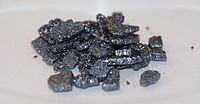
Photo from wikipedia
Isolated impurity states in epitaxially grown semiconductor systems possess important radiative features such as distinct wavelength emission with a very short radiative lifetime and low inhomogeneous broadening, which make them… Click to show full abstract
Isolated impurity states in epitaxially grown semiconductor systems possess important radiative features such as distinct wavelength emission with a very short radiative lifetime and low inhomogeneous broadening, which make them promising for the generation of indistinguishable single photons. In this study, we investigate chlorine-doped ZnSe/ZnMgSe quantum well (QW) nanopillar (NP) structures as a highly efficient solid-state single-photon source operating at cryogenic temperatures. We show that single photons are generated due to the radiative recombination of excitons bound to neutral Cl atoms in ZnSe QW and the energy of the emitted photon can be tuned from about 2.85 down to 2.82 eV with ZnSe well width increase from 2.7 to 4.7 nm. Following the developed advanced technology, we fabricate NPs with a diameter of about 250 nm using a combination of dry and wet-chemical etching of epitaxially grown ZnSe/ZnMgSe QW structures. The remaining resist mask serves as a spherical- or cylindrical-shaped solid immersion lens on top of NPs and leads to the emission intensity enhancement by up to an order of magnitude in comparison to the pillars without any lenses. NPs with spherical-shaped lenses show the highest emission intensity values. The clear photon-antibunching effect is confirmed by the measured value of the second-order correlation function at a zero time delay of 0.14. The developed single-photon sources are suitable for integration into scalable photonic circuits.
Journal Title: ACS nano
Year Published: 2022
Link to full text (if available)
Share on Social Media: Sign Up to like & get
recommendations!